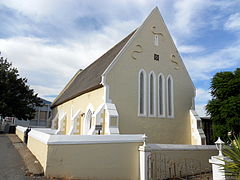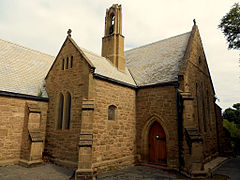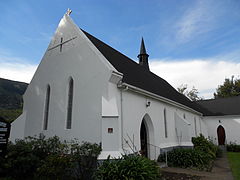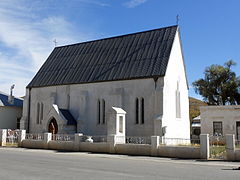This article includes a list of general
references, but it lacks sufficient corresponding
inline citations. (March 2023) |
Sophy Gray | |
|---|---|
| Born | 5 January 1814 Easington in
Yorkshire |
| Died | 27 April 1871 (aged 57) Cape Town |
| Known for | Architecture |
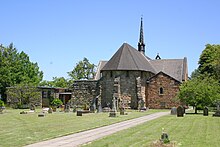
Sophy Gray or Sophia Gray (5 January 1814 – 27 April 1871), [1] was a diocesan administrator, artist, architect, horsewoman and the wife of Cape Town bishop Robert Gray. Born at Easington in Yorkshire, the 5th daughter of county squire Richard Wharton Myddleton of Durham and Yorkshire, she died at Bishopscourt, Cape Town on 27 April 1871 and was buried in the graveyard of St Saviour's in Claremont. Day 1930 wrote "the constant companion of (Robert Gray's) travels, the untiring amanuensis and accountant, the skilful designer of churches, the brightness and stay of his home life at Bishopscourt."
England
Sophy and her two sisters were raised in an affluent family, owning estates in North Riding and Durham. They were well-read and proficient riders from an early age, qualities that helped foster their friendship with the young Robert Gray. Sophy married Robert Gray in 1836 after a six-month engagement, when he was rector of Whitworth, Durham. Their honeymoon gave young Sophy a taste of things to come when she and Robert set out on a lengthy horseback trip, visiting the family holdings in two counties. For nine years their lives at Old Park and Whitworth, and the urban parish of Stockton remained fairly untroubled, but all this changed dramatically when Robert was placed on a shortlist for one of three new colonial bishoprics. He was chosen for the Cape of Good Hope.
South Africa
In 1847 Sophy and Robert travelled to Cape Town where he was to establish a new colonial diocese, increase the number of clergy and establish new churches and schools. There were only ten Anglican churches in South Africa at that time. With his death 25 years later, this number had risen to 63. Having grown accustomed to the high standard of living enjoyed by bishops, including an episcopal palace, the Grays emigrated to the Cape with a retinue of servants, furniture and even an episcopal carriage.
The couple settled on the farm Boschheuvel, originally named Wijnberg and later renamed Bishopscourt, the original owner having been Jan van Riebeek, first Dutch Governor of the Cape. The farm lay on the slopes of Table Mountain, well-watered and with dense woodland. Here Sophy, using the old slave quarters, started a school for her five children and those of the community. Despite disliking social engagements, she kept open house to a constant stream of church officials and dignitaries, as well as managing Robert's diocese that included the Cape, Orange Free State, Natal and the islands of Tristan da Cunha and St. Helena.
Sophy Gray had brought along architectural plans of churches that could be adapted to the design of churches and schools for the new Anglican parishes that were to be established throughout South Africa. Both Sophy and her husband favoured the neo-Gothic style of church architecture which was fashionable in Britain at that time and advocated by the ecclesiologists, and disliked the Romanesque style. Even so, Sophy and Robert Gray felt that church design should not stick slavishly to the Early English Period, but should show some diversity.
She not only filled the role of architect, but kept records of the synods, their meetings and official ceremonies. She also kept records of correspondence and church chronicles. Being a competent horsewoman, she joined her husband on all but two of his extended trips. Her artistic skills were shown by the numerous water-colours and sketches she did, frequently used to illustrate her husband's journals. In all, the bishop would hardly have managed without her able assistance and knowledge. As if in recognition of her contribution, there is a stained glass window in St George's Cathedral, depicting her wearing a green riding habit and bonnet, though usually she wore a felt hat and plain riding dress, beneath which were close-fitting riding breeches of Chamois leather.
Capetonian Desmond Martin's doctoral thesis dealt with the churches established by the Grays. Of more than 50 churches built in South Africa during Robert Gray's bishopric, at least 40 were designed by Sophy. In 2005 Martin published a book titled "The Bishop's Churches" and illustrated with his water-colours and line drawings of her 40 churches, including St Paul's, Rondebosch, St Saviour's, Claremont, St Peter's, Plettenberg Bay, St James, Graaff-Reinet and St Jude's, Oudtshoorn.
Churches designed by Sophy Gray
Gallery
-
Holy Trinity Church, Caledon (1850)
-
St Luke's Mission Church, Swellendam (1869)
-
St Jude's Church, Oudtshoorn (1860)
-
All Saints Church, Somerset East (1854)
-
St George's Church, Knysna (1849)
-
St John's Church, Victoria West (1869)
-
School Chapel, Beaufort West (1849)
-
All Saints Church, Uniondale (1869)
-
St James the Great, Worcester (1852)
See also
References
Notes
- ^ St Paul's, Eerste River is closer to Faure
- ^ St Saviour's, Claremont was demolished in 1904. [2]
- ^ Christ Church, Swellendam was demolished and a new church built on the old foundations. [2]
- ^ St Paul's, North End was demolished in 1959. [2]
- ^ St Andrew's Chapel, Newlands is no longer in use as a church
- ^ Armstrong Memorial Chapel was demolished in 1950. [2]
- ^ Constantia Chapel was demolished in 1953 [3]
- ^ St Mark's Chapel, District Six was demolished in the 1960s. [2]
- ^ St Augustine's Chapel has become an Afrikaans Protestant Church after the dissolution of the Anglican congregation. [4]
- ^ St Luke's Mission Church, Swellendam is now used by the Old Apostolic Church. [2]
Citations
- ^ "GRAY, Sophia Wharton Myddleton (Sophy)". www.artefacts.co.za. Retrieved 23 March 2023.
- ^ a b c d e f "Sophy Gray Churches". Lu-Gerda's Travels. Retrieved 13 November 2015.
- ^ Martin 2002, p. 192.
- ^ van Rooyen, Morné (2015). "St Augustine's Church details". artefacts.co.za. Retrieved 28 June 2018.
Sources
- Day, E. Hermitage (1930). Robert Gray: First Bishop of Cape Town. London: S.P.C.K.
- Gutsche, Thelma (1970). The Bishop's Lady. H. Timmins.
- Martin, Desmond (2002). The churches of Bishop Robert Gray & Mrs Sophia Gray : an historical and architectural review (Ph.D.). UCT. hdl: 11427/10637.
- Martin, Desmond (2005). The Bishop's Churches. Struik. ISBN 978-1-77007-155-1.
- Potgieter, D. J., ed. (1972). Standard Encyclopaedia of Southern Africa. Vol. 5 For - Hun. Cape Town: Nasou. ISBN 978-0-625-00321-1.
- Radford, Dennis John Charles (1979). The architecture of the Western Cape, 1838 1901. A study of the impact of Victorian aesthetics and technology on South African architecture (Ph.D thesis). Johannesburg: Dept of Arch. University of the Witwatersrand. p. 207. hdl: 10539/18096.
External links
Portraits of Sophy Gray at the National Portrait Gallery, London

